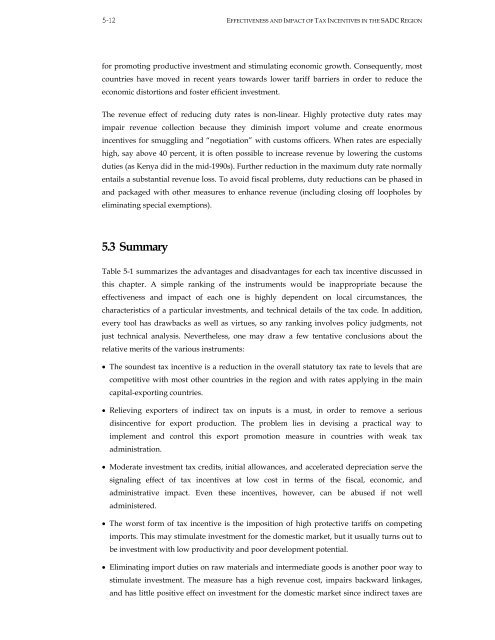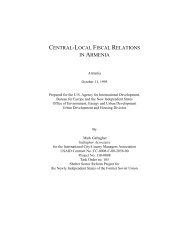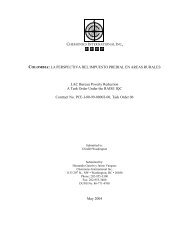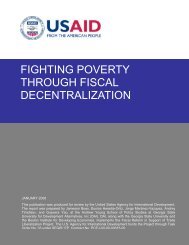Effectiveness and Economic Impact of Tax Incentives in the SADC ...
Effectiveness and Economic Impact of Tax Incentives in the SADC ...
Effectiveness and Economic Impact of Tax Incentives in the SADC ...
Create successful ePaper yourself
Turn your PDF publications into a flip-book with our unique Google optimized e-Paper software.
5-12 EFFECTIVENESS AND IMPACT OF TAX INCENTIVES IN THE <strong>SADC</strong> REGION<br />
for promot<strong>in</strong>g productive <strong>in</strong>vestment <strong>and</strong> stimulat<strong>in</strong>g economic growth. Consequently, most<br />
countries have moved <strong>in</strong> recent years towards lower tariff barriers <strong>in</strong> order to reduce <strong>the</strong><br />
economic distortions <strong>and</strong> foster efficient <strong>in</strong>vestment.<br />
The revenue effect <strong>of</strong> reduc<strong>in</strong>g duty rates is non-l<strong>in</strong>ear. Highly protective duty rates may<br />
impair revenue collection because <strong>the</strong>y dim<strong>in</strong>ish import volume <strong>and</strong> create enormous<br />
<strong>in</strong>centives for smuggl<strong>in</strong>g <strong>and</strong> “negotiation” with customs <strong>of</strong>ficers. When rates are especially<br />
high, say above 40 percent, it is <strong>of</strong>ten possible to <strong>in</strong>crease revenue by lower<strong>in</strong>g <strong>the</strong> customs<br />
duties (as Kenya did <strong>in</strong> <strong>the</strong> mid-1990s). Fur<strong>the</strong>r reduction <strong>in</strong> <strong>the</strong> maximum duty rate normally<br />
entails a substantial revenue loss. To avoid fiscal problems, duty reductions can be phased <strong>in</strong><br />
<strong>and</strong> packaged with o<strong>the</strong>r measures to enhance revenue (<strong>in</strong>clud<strong>in</strong>g clos<strong>in</strong>g <strong>of</strong>f loopholes by<br />
elim<strong>in</strong>at<strong>in</strong>g special exemptions).<br />
5.3 Summary<br />
Table 5-1 summarizes <strong>the</strong> advantages <strong>and</strong> disadvantages for each tax <strong>in</strong>centive discussed <strong>in</strong><br />
this chapter. A simple rank<strong>in</strong>g <strong>of</strong> <strong>the</strong> <strong>in</strong>struments would be <strong>in</strong>appropriate because <strong>the</strong><br />
effectiveness <strong>and</strong> impact <strong>of</strong> each one is highly dependent on local circumstances, <strong>the</strong><br />
characteristics <strong>of</strong> a particular <strong>in</strong>vestments, <strong>and</strong> technical details <strong>of</strong> <strong>the</strong> tax code. In addition,<br />
every tool has drawbacks as well as virtues, so any rank<strong>in</strong>g <strong>in</strong>volves policy judgments, not<br />
just technical analysis. Never<strong>the</strong>less, one may draw a few tentative conclusions about <strong>the</strong><br />
relative merits <strong>of</strong> <strong>the</strong> various <strong>in</strong>struments:<br />
•<br />
•<br />
•<br />
•<br />
•<br />
The soundest tax <strong>in</strong>centive is a reduction <strong>in</strong> <strong>the</strong> overall statutory tax rate to levels that are<br />
competitive with most o<strong>the</strong>r countries <strong>in</strong> <strong>the</strong> region <strong>and</strong> with rates apply<strong>in</strong>g <strong>in</strong> <strong>the</strong> ma<strong>in</strong><br />
capital-export<strong>in</strong>g countries.<br />
Reliev<strong>in</strong>g exporters <strong>of</strong> <strong>in</strong>direct tax on <strong>in</strong>puts is a must, <strong>in</strong> order to remove a serious<br />
dis<strong>in</strong>centive for export production. The problem lies <strong>in</strong> devis<strong>in</strong>g a practical way to<br />
implement <strong>and</strong> control this export promotion measure <strong>in</strong> countries with weak tax<br />
adm<strong>in</strong>istration.<br />
Moderate <strong>in</strong>vestment tax credits, <strong>in</strong>itial allowances, <strong>and</strong> accelerated depreciation serve <strong>the</strong><br />
signal<strong>in</strong>g effect <strong>of</strong> tax <strong>in</strong>centives at low cost <strong>in</strong> terms <strong>of</strong> <strong>the</strong> fiscal, economic, <strong>and</strong><br />
adm<strong>in</strong>istrative impact. Even <strong>the</strong>se <strong>in</strong>centives, however, can be abused if not well<br />
adm<strong>in</strong>istered.<br />
The worst form <strong>of</strong> tax <strong>in</strong>centive is <strong>the</strong> imposition <strong>of</strong> high protective tariffs on compet<strong>in</strong>g<br />
imports. This may stimulate <strong>in</strong>vestment for <strong>the</strong> domestic market, but it usually turns out to<br />
be <strong>in</strong>vestment with low productivity <strong>and</strong> poor development potential.<br />
Elim<strong>in</strong>at<strong>in</strong>g import duties on raw materials <strong>and</strong> <strong>in</strong>termediate goods is ano<strong>the</strong>r poor way to<br />
stimulate <strong>in</strong>vestment. The measure has a high revenue cost, impairs backward l<strong>in</strong>kages,<br />
<strong>and</strong> has little positive effect on <strong>in</strong>vestment for <strong>the</strong> domestic market s<strong>in</strong>ce <strong>in</strong>direct taxes are











